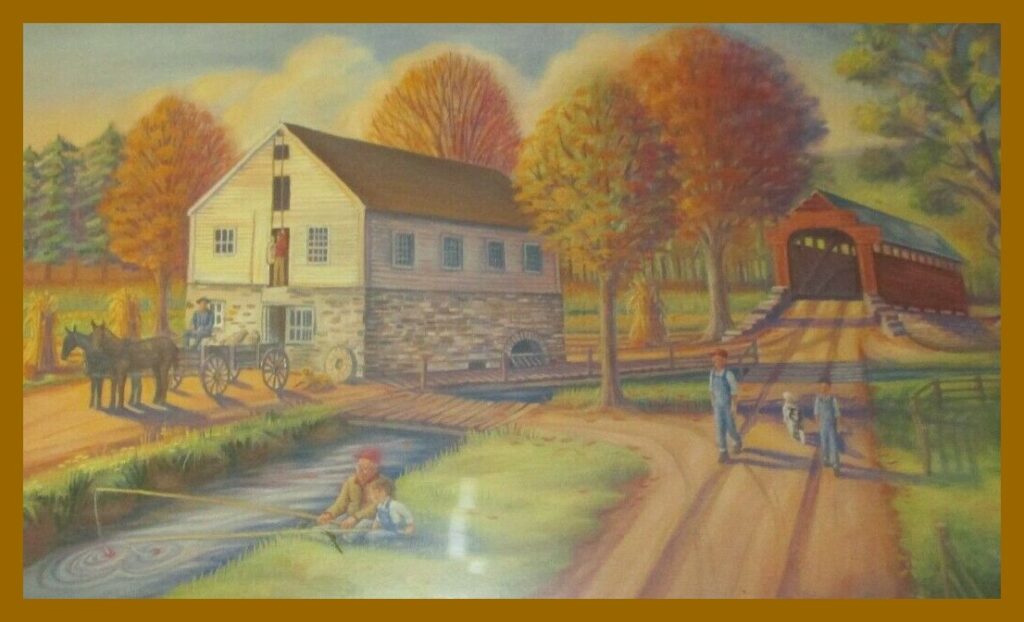
A snapshot photograph of a portion of a limited edition print of an oil painting by Deanna Wiseman who was raised in Pillow, Dauphin County, Pennsylvania. The print was sold under the title, “Early Mahantongo Grist Mill” by Wiseman Graphics, P. O. Box 383, Herndon, Pennsylvania 17830.
The following information about the mill was provided by the artist:
The Mahantongo Valley Grist Mill was built in 1808 by a man named Daniel Herb. It was conceived by the Klinger family, which immigrated from Germany to America in 1749. The mill was built to attract settlers. The family utilized water from two streams, known as the Pine and Mahantongo Creeks. From these streams, the mill got its power and the village known as Klingerstown grew and flourished. One of the earliest operators of the mill was Jacob Klinger. The covered bridge which stretched across the Mahantongo Creek was replaced in 1941 by a more modern bridge.
________________________________________________
When the print was released in 2007, the Citizens-Standard of Valley View, May 16, 2007, ran the following article about the artist and the mill”
ARTIST RELEASES FIFTH LIMITED EDITION PRINT OF KLINGERSTOWN AREA
By Danelle Carvell, Freelance Writer
KLINGERSTOWN – Just in time for the Klingerstown Bicentennial in June, artist Deanna Wiseman will release her fifth limited-edition print representing the Klingerstown area. “The Early Mahantongo Valley Grist Mill” is an artist’s portrayal of the mill and covered bridge that oine stood among the Mahantongo and Pine Creeks. Set in the 1920’s, the print depicts a busy day in autumn as mill workers and townspeople engage in both work and leisure activities.
Perhaps the most challenging of nine prints she has released, Wiseman described her latest work as the piecing together of a puzzle. “Walking the area around the mill gave a few tell-tale signs of how the landscape looked in 1920,” said Wiseman, A stone foundation where the covered bridge once stood is still visible today. But visible evidence was not enough to reconstruct the landscape and buildings as they were back then.
Fortunately, a few people were happy to share their photos and stories of the old mill. Nancy [Stiely] Shaffer, who lives close to the mill, showed Wiseman where the race once ran through her front yard. Shaffer’s late father, Lawrence “Lutz” Stiely, once worked at the mill, so she had both memories and photos to share.
Another person who had a hand in the print’s process is Bryant Troutman of Klingerstown. Recreating the mill and covered bridge through a painting was initially his idea. He asked Wiseman to take on the job last spring. Of the four Klingerstown area prints, he commissioned the artist to create, he says he is most excited about this one. “I appreciate the olden days,” says Troutman, who was born “one generation too late” to know about water power first hand.
A lover of history, Troutman gathered memories of the mill by talking to some of the older residents in the area. Born in 1915, Mae [Kessler] Deppen spent a lot of time as a young girl at the mill in the early 1920s. Her grandfather, William Zerby, operated the mill at that time. She recalled that they roasted ear corn and ground mush as well as different kinds of grain flour. “William would take it by horse-drawn wagon to the Keffer’s railroad station at Good Spring for shipment to the city market,” Deppen remembered. A horse-drawn wagon waiting for a load of mill product is featured in Wiseman’s print.
According to Steve Troutman, a Klingerstown historian, the Mahantongo Valley Grist Mill was built in 1908 by a man named Daniel Herb. Conceived by the Klinger family, which originated in Germany, the mill was built to attract settlers. Alexander Klinger immigrated from Germany to America in 1749 and eventually owned land in the Klingerstown area. The town’s founder was Alexander’s son, Johannes Klinger (1758-1800). He had sold several lots before his death.
Several Klinger mills had existed in the Odenwalt for many generations in Germany. In Klingerstown, the family utilized water from two streams, known today as the Pine and Mahantongo Creeks. From these streams, the mill got its power and the village of Klingerstown grew and flourished. One of the earliest operators of the mill was Jacob Klinger.
“There is nothing new under the sun,” said Bryant Troutman. “When we picture in our minds the time when the tone mill and wooden covered bridge were built, we are reminded of I Chronicles 22:15, which reads, “Moreover there are workmen with thee in abundance, hewers, and workers of stone and timber.”
The Mahantongo Valley Grist Mill is still standing today, although there have been rumors about it being town down. The covered bridge that once stretched across the Mahantongo Creek was replaced in 1941 by a more modern bridge. Both these symbols of Klingerstown history will be forever preserved in Wiseman’s latest print which will be in display at a Hearth Bread Bake and homefront re-enactment, being held June 10th at the old Victor Troutman and Sallie Troutman Farm in Klingerstown. The print will also be on display at Wiseman Graphics, Route 147, Herndon.
Wiseman has hundreds of original paintings and prints displayed in private collections around the world. She is a member of the American Society of Portrait Artists, the Art Association of Harrisburg, and the Millersburg Art Association, where she teaches. Her work has earned many awards, including a 2006 Best of Show award for an earlier Klingerstown print titled, “Winter Shadows Along Fisher’s Ridge.”
_______________________________________________
Corrections and additional information should be added as comments to this post.